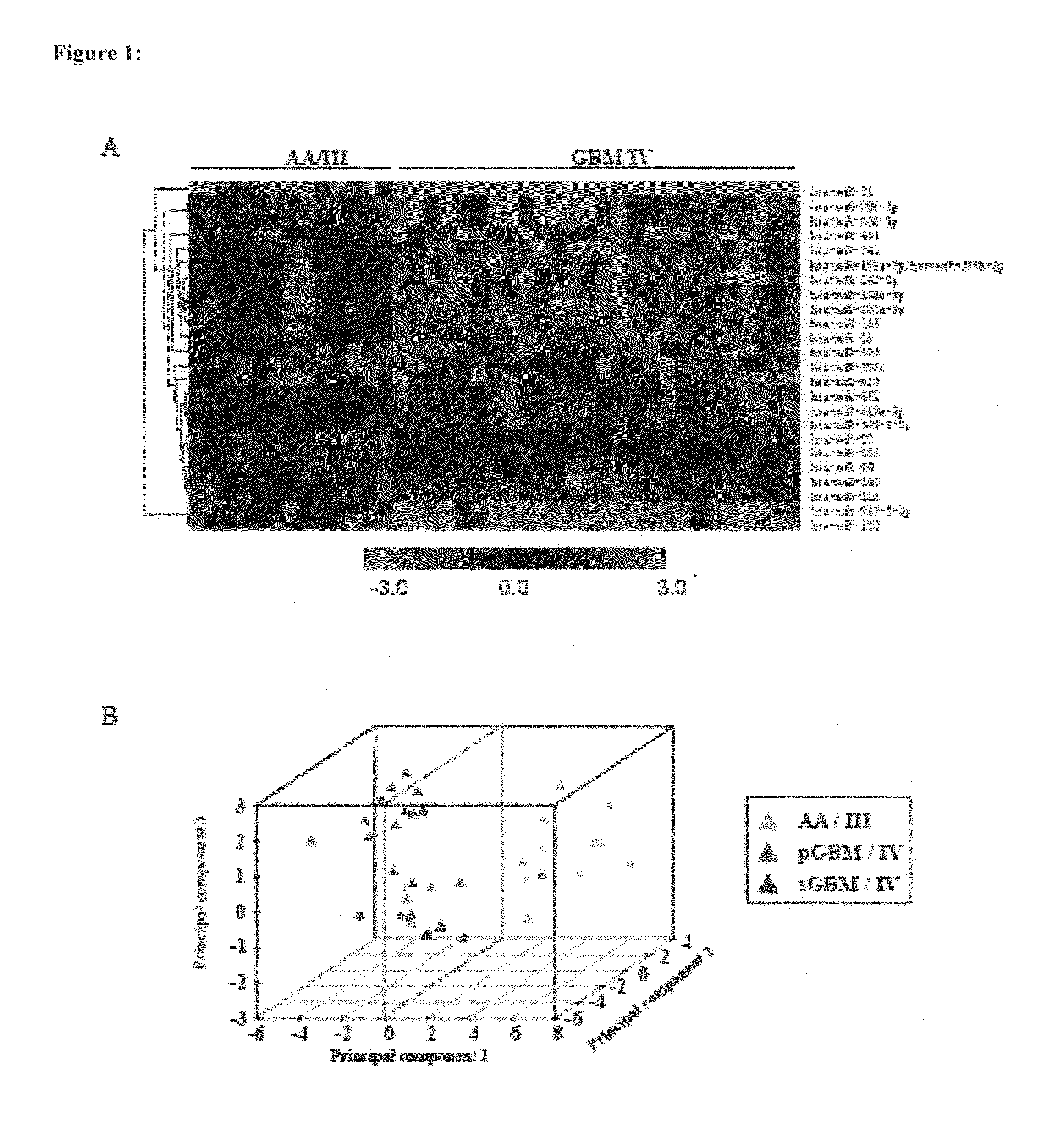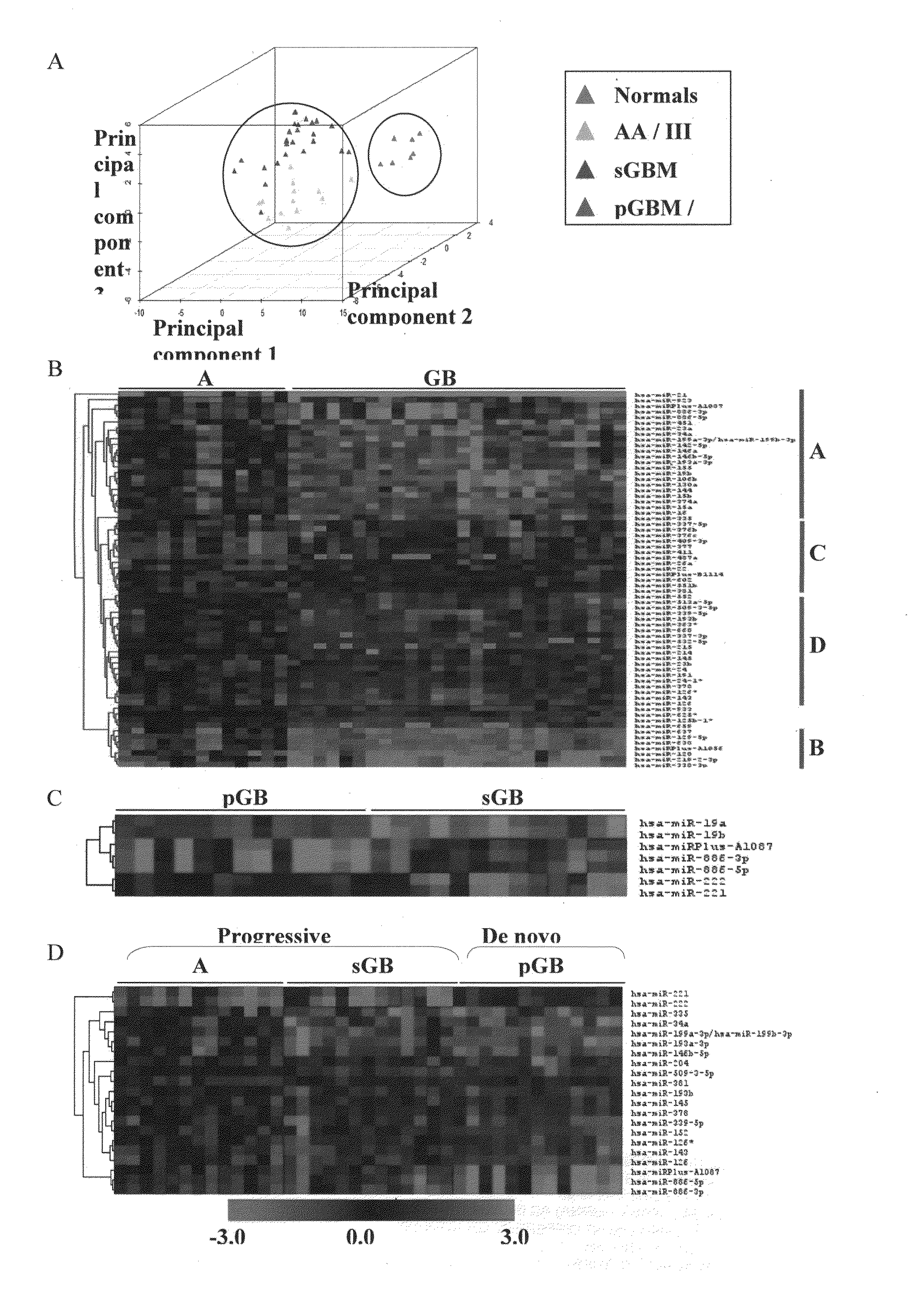MicroRNAa (miRNA) AS BIOMARKERS FOR DIAGNOSING DIFFERENT GRADES OF GLIOMAS AND PATHWAYS OF GLIOMA PROGRESSION
a technology of glioma progression and micrornas, which is applied in the field of micrornas (mirna) as biomarkers for detecting glioma progression pathways, can solve the problems of chemotherapy, insufficient understanding of astrocytoma development, and insufficient prognosis of gbm patients, etc., to achieve accurate classification of different grades of glioma
- Summary
- Abstract
- Description
- Claims
- Application Information
AI Technical Summary
Benefits of technology
Problems solved by technology
Method used
Image
Examples
example 1
[0066]Tissue Collection
[0067]Tumor samples were collected from patients who were operated at National Institute of Mental Health and Neurosciences and. Sri Satya Sai Institute of Higher Medical Sciences, Bangalore, India. A portion of the non-dominant anterior temporal cortex resected during surgery for intractable epilepsy served as normal control brain sample. A total of 73 samples of malignant astrocytoma and control brain tissue were used in this study. For microarray hybridization, a set of 39 samples of malignant astrocytoma comprising 13 AA, 13 sGBM and 13 pGBM tissues and 7 controls were used. For subsequent real time RT-PCR validation of selected miRNAs, we used an independent set of 24 samples of GBM and 3 controls. Tissues were bisected, and one half was snap-frozen in liquid nitrogen and stored at −8020 C. until RNA isolation. The other half was fixed in formalin and processed for paraffin sections. These were used for histopathologic grading of astrocytoma and immunohis...
example 2
[0068]Total RNA was extracted from the frozen tissue or cell lines by using the TRI reagent (Sigma) as per the manufacturer's instructions. The RNA samples were quantified by measuring the absorbance using a spectrophotometer and visualized on a MOPS-formaldehyde gel for quality assurance. For the RNA samples used in microarray experiment, the quality and quantity was verified by using Bioanalyzer 2100 (Agilent).
[0069]MicroRNA Array Profiling
[0070]One μg total RNA from sample and reference were labeled with Hy3™ and Hy5™ fluorescent label, respectively, using the miRCURY™ LNA Array power labeling kit (Exiqon, Denmark) following the procedure described by the manufacturer. The Hy3™-labeled samples and a Hy5™-labeled reference RNA sample were mixed pair-wise and hybridized to the miRCURY™ LNA array version 10.0 (Exiqon, Denmark), which contains capture probes targeting all miRNAs for all species registered in the miRBASE version 10.0 at the Sanger Institute. The hybridization was perf...
example 3
[0071]Data analysis
[0072]The median ratio of Hy3 / Hy5 intensity for replicative spots for each miRNA was obtained after normalization. The ratio Hy3 / Hy5 values were log2 transformed. Difference in log2 ratio for each miRNA is obtained by subtracting the log2 ratio of a given sample from the average log2 ratio of normals. The difference in log2 ratio was considered in subsequent analyses. We have analyzed 7 normals, 13 AA (Grade III), 13 primary GBM (Grade IV) and 13 secondary GBM (Grade IV) by microarray hybridization. The miRNAs having values in at least 70% of the samples in each group were considered for further analysis. To find the significantly differentially regulated miRNAs between normal brain and astrocytoma and between the groups of malignant astrocytoma, data were analyzed by Significance Analysis of Microarrays (SAM). In SAM analysis, P values were obtained from permutation tests (1000 permutations in each analysis). The significant genes that were identified by SAM were...
PUM
| Property | Measurement | Unit |
|---|---|---|
| Fraction | aaaaa | aaaaa |
| Fraction | aaaaa | aaaaa |
| Fraction | aaaaa | aaaaa |
Abstract
Description
Claims
Application Information
 Login to View More
Login to View More - R&D
- Intellectual Property
- Life Sciences
- Materials
- Tech Scout
- Unparalleled Data Quality
- Higher Quality Content
- 60% Fewer Hallucinations
Browse by: Latest US Patents, China's latest patents, Technical Efficacy Thesaurus, Application Domain, Technology Topic, Popular Technical Reports.
© 2025 PatSnap. All rights reserved.Legal|Privacy policy|Modern Slavery Act Transparency Statement|Sitemap|About US| Contact US: help@patsnap.com



